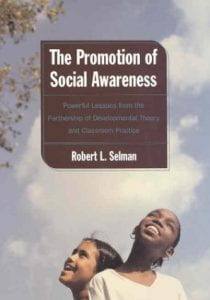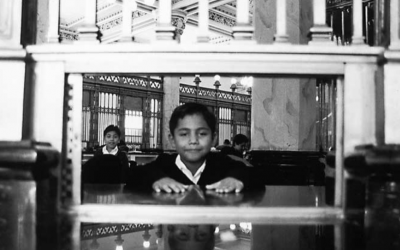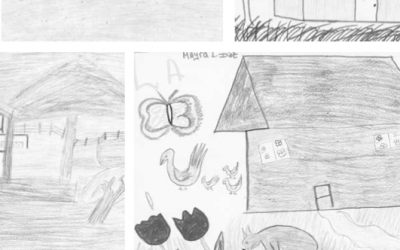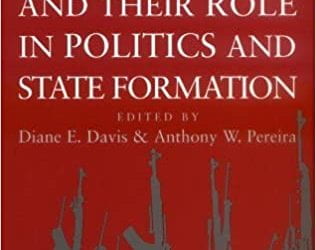A Review of The Promotion of Social Awareness: Powerful Lessons from the Partnership of Developmental Theory and Classroom Practice
Learning to Walk in Someone Else’s Shoes

The Promotion of Social Awareness: Powerful Lessons from the Partnership of Developmental Theory and Classroom Practice By Robert L. Selman, Russell Sage Foundation, 2003
When picked on, some children choose to fight and others choose to walk away. What accounts for these different responses? This is just one of the many questions that Robert Selman, an accomplished social development theorist and practicebased researcher, explores in his highly engaging book, The Promotion of Social Awareness.
Selman’s work is as much a narrative about effective collaborative work and the on-going process of testing theoretical notions as it is about the social development of children. Early on in the book, Selman introduces himself to the reader, letting us know where he has been throughout his academic journey so that we can appreciate the contexts that underlie his ideas. For example, we learn that he has spent more than thirty years examining “the coordination of social perspectives— how children come to identify their own needs, wants, and feelings, understand those of others, and act to manage differences and conflicts, as well as closeness, within relationships” (2). Selman goes on to tell us that, after conducting therapeutic work with troubled children, he now comprehends that at different developmental stages children possess different personal meanings regarding “the risks involved in a social interaction, incident, or relationship,” and that this is what bridges the gap between thought and action (45). With the help of his colleagues, Selman’s insight into the relationship between action and thought led to the Risk and Relationship Framework that is presented in this book.
Moreover, Selman and his colleagues refined their theoretical framework by putting it into practice, which they were able to do as part of the Group for the Study of Interpersonal Development. Through their partnership with Voices of Love and Freedom, Inc. (VLF), an organization geared towards helping teachers facilitate better social relationships between children, they conducted research in the Boston public schools. The research team found that in order for students to learn social perspective skills their teachers have to be competent and committed to the endeavor of promoting social awareness.
With this in mind, Selman traveled to Iceland, where he and his colleague, Sigrun Adalbjarnardotttir, worked with a group of teachers who were teaching their students social competence and, thus, were able to re-examine their theoretical notions. In the chapters devoted to his work in Iceland, wherein Selman describes the process of going back and forth between practice and theory, he meticulously presents the real world complexities that lead to the reformulation of the social developmental theory discussed in the book.
One of the most attention-grabbing sections of the book is Part IV. In this section, the chapters are essentially an ethnographic case study of how Angela Burgos, a fifth grade teacher, made use of one of the VLF books and its social literacy curriculum. Selman presents excerpts from six weeks of video collected by the research team’s camera crew. These excerpts, as the author himself suggests, allow the reader to examine both Burgos’ teaching practices and the manner in which her Spanish- English bilingual students wrestle with prejudice and discrimination as they acquire social awareness skills.
According to Selman, it is not his intention to advocate for a particular educational approach. Yet, he makes no qualms about the fact that he and his colleagues believe schools must help children become “socially literate.” He states:
Instead of avoiding socially charged themes like fairness, prejudice, and justice, as many educators, policymakers, and test designers might have us do, we embrace them. We would never endorse a test for ‘correct’ opinions on these issues, but we think social concerns need to be part of education and therefore part of learning assessment (242).
Based on my own ethnographic observations of middle school children, I agree with Selman that social literacy is important, if for no other reason than the fact that fairness matters a great deal to preadolescents and adolescents.
The Promotion of Social Awareness is teeming with information and ideas that practitioners and researchers, among others, should reflect on and discuss. Not only is this book worth reading, it necessitates a close reread in order to grasp the many subtle insights that Selman puts forth regarding social awareness, risk behavior, collaborative work, and more, as he elaborates on a decades-long “circular researchbased practice/practice-based research enterprise” (4).
Winter 2004, Volume III, Number 2
Richard Mora is a graduate student in the Sociology and Social Policy Ph.D. program at Harvard University. He contributes frequently to ReVista.
Related Articles
Editor’s Letter: The Children
A blue whale spurts water joyfully into an Andean sky on my office door. A rainbow glitters among a feast of animals and palm trees. Geometrical lightning tosses tiny houses into the air with the force of a tropical hurricane.
Centroamerica
Cuando Pedro Pirir, fue despedido del taller mecánico donde trabajaba desde hacía muchos años, experimentó una sensación de injusticia y pena que luego se transformó en una voluntad…
Irregular Armed Forces and their Role in Politics and State Formation
As I sat in heavy traffic in the back of a police car during rush hour in the grimy northern zone of Rio de Janeiro, I studied the faces of drivers in neighboring cars, wondering what they thought of…




